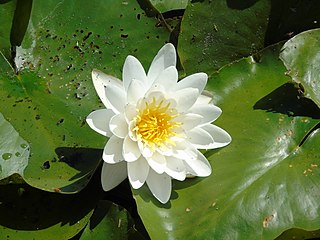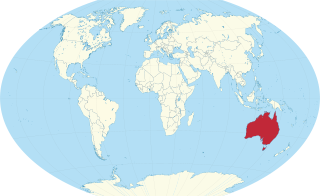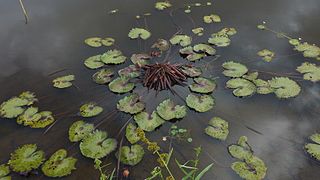
Nymphaeaceae is a family of flowering plants, commonly called water lilies. They live as rhizomatous aquatic herbs in temperate and tropical climates around the world. The family contains five genera with about 70 known species. Water lilies are rooted in soil in bodies of water, with leaves and flowers floating on or rising from the surface. Leaves are oval and heart-shaped in Barclaya. Leaves are round, with a radial notch in Nymphaea and Nuphar, but fully circular in Victoria and Euryale.

Victoria or giant waterlily is a genus of aquatic herbs in the plant family Nymphaeaceae. Its leaves have a remarkable size: Victoria boliviana produces leaves up to 3.2 metres (10 ft) in width. The genus name was given in honour of Queen Victoria of the United Kingdom.

Nymphaea is a genus of hardy and tender aquatic plants in the family Nymphaeaceae. The genus has a cosmopolitan distribution. Many species are cultivated as ornamental plants, and many cultivars have been bred. Some taxa occur as introduced species where they are not native, and some are weeds. Plants of the genus are known commonly as water lilies, or waterlilies in the United Kingdom. The genus name is from the Greek νυμφαία, nymphaia and the Latin nymphaea, which means "water lily" and were inspired by the nymphs of Greek and Latin mythology.

Nymphaea mexicana is a species of aquatic plant that is native to the Southern United States and Mexico as far south as Michoacán. Common names include yellow water lily, Mexican water lily and banana water lily.

Nymphaea ondinea is an aquatic plant in the family Nymphaeaceae native to northwestern Australia.

Nymphaea thermarum, also known as Pygmy Rwandan water lily, is a species of water lily that is endemic to Rwanda. Once thought to be extinct in the wild, all wild plants were believed to be lost due to destruction of its native habitat, but it was thought to be saved from extinction when it was grown from seed at the Royal Botanic Gardens, Kew in 2009. A previously-unknown wild population was discovered in 2023.

Nymphaea rudgeana is a species of waterlily native to the region spanning from Mexico to tropical South America.

Nymphaea atrans is a species of waterlily is endemic to Queensland, Australia.

Nymphaea carpentariae is a species of waterlily native to Queensland and Western Australia.

Nymphaea georginae is a species of waterlily native to the Northern Territory, and the state of Queensland, Australia.

Nymphaea hastifolia is a species of waterlily native to the Northern Territory, and Western Australia.

Nymphaea immutabilis is a species of waterlily native to Western Australia, the Northern Territory, and Queensland, Australia.

Nymphaea jacobsii is a species of waterlily endemic to Queensland, Australia.

Nymphaea kakaduensis is a species of waterlily endemic to the Northern Territory, Australia.

Nymphaea kimberleyensis is a species of waterlily endemic to Western Australia.

Nymphaea loriana is a species of waterlily endemic to Manitoba, and Saskatchewan, Canada.

Nymphaea subg. Anecphya is a subgenus of the genus Nymphaea.

Nymphaea subg. Confluentes is a subgenus of the genus Nymphaea.

Trithuria bibracteata is a species of aquatic plant in the family Hydatellaceae endemic to Western Australia.

Nymphaea ondinea subsp. petaloidea is a subspecies of Nymphaea ondinea native to the Northern Territory, and Western Australia.












